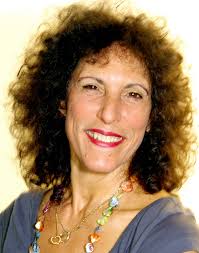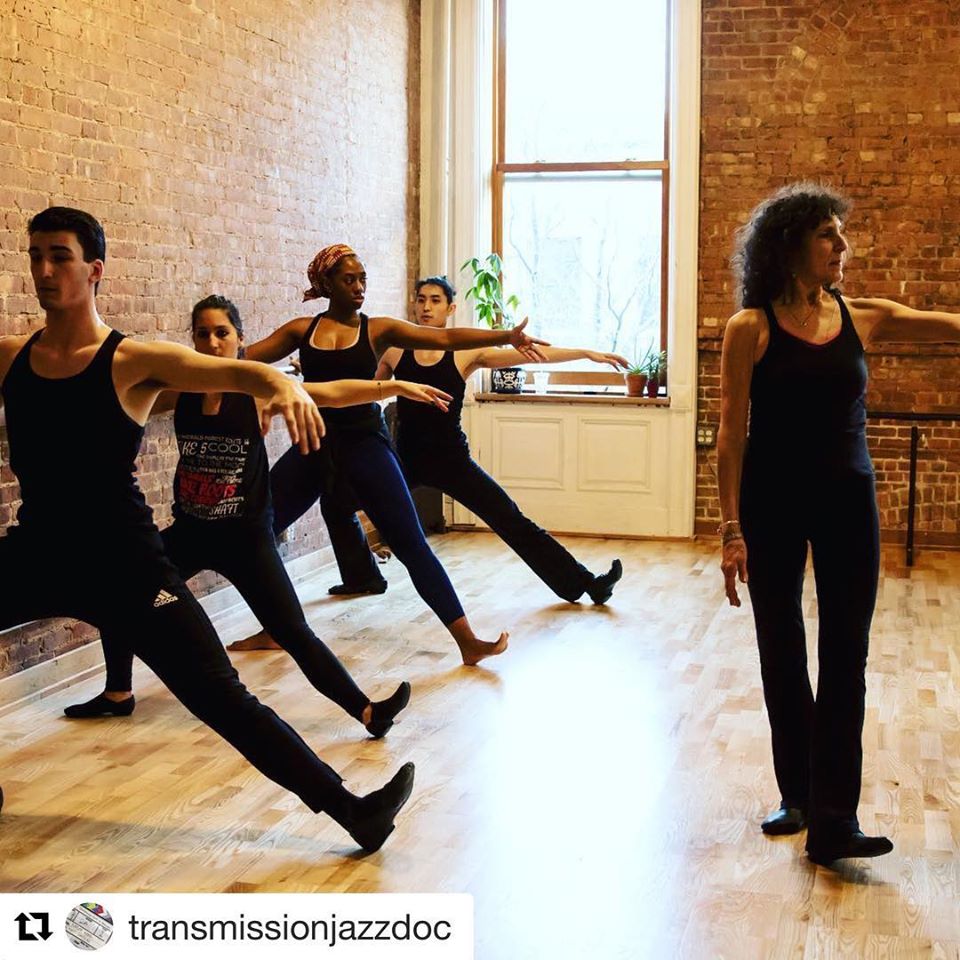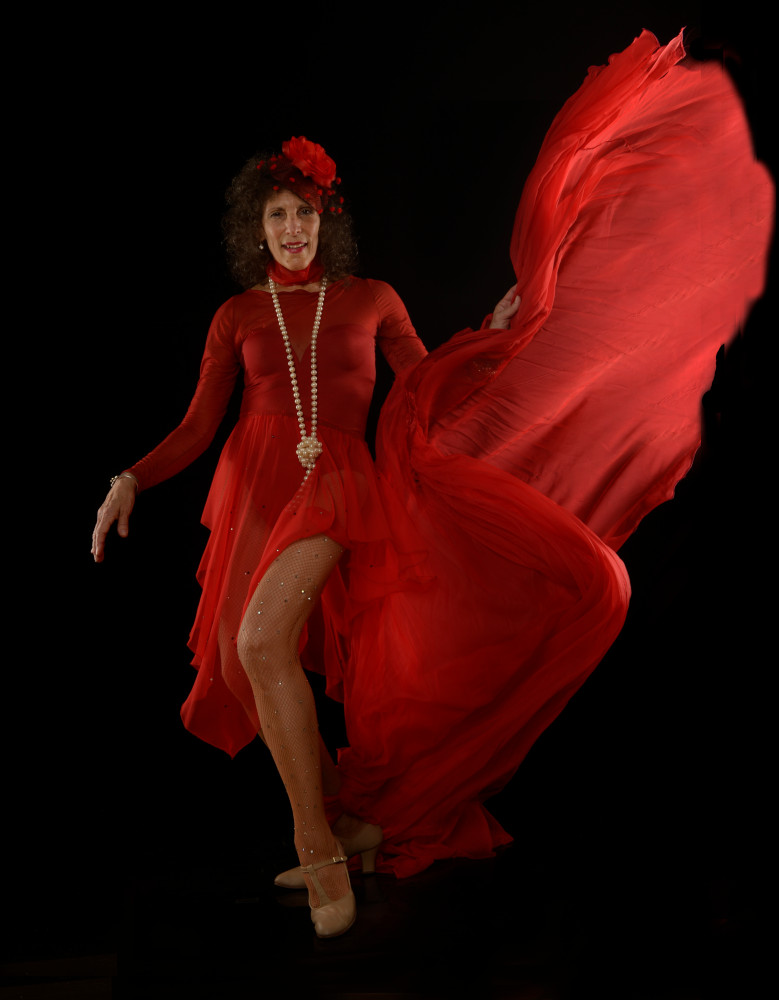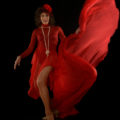After Charles Goddertz, we talk with Sue Samuels, a well-known jazz dance teacher in NYC and founder of Jazz Roots Dance Company.

1. Photo by courtesy of Sue Samuels
Sue Samuels is a famous jazz dance personality in the USA. Mother of Elka and Jason Samuels Smith, she is the founder of Jazz Roots Dance Company, a very well established jazz dance company based in New York with a repertory of Jo Jo Smith‘s works and other important jazz dance choreographers, like Matt Mattox, Bob Fosse, Jack Cole, and Luigi.
Sue Samuels received the Flo-Bert Award from the NY Committee To Celebrate National Tap Dance Day for her many contributions to both the Jazz and Tap dance community.
Performance and choreographic credits include lead dancer and assistant choreographer in shows like Got Tu Go Disco, The Johnny Hallyday Show, and The Brazil Export Show.
Sue Samuels is also a renowned jazz dance teacher. She was the co-founder and owner of Jo Jo’s Dance Factory in New York City for ten years, which later became Broadway Dance Center, where you can find her teaching classic jazz dance.
Hello Sue Samuels, it is a great honour to have you as our guest on Tutto Mondo News.
What is jazz dance for you and what do you love about it?
«Jazz dance for me is in the classic form which was born in the 1950s and ’60s in New York City. The style I enjoy dancing and teaching was created by the Jazz Dance Master Jo Jo Smith. His style was considered to be “funky” compared to the other Jazz teachers/choreographers of that time.I came to learn Jazz Dance after I had trained
for many years in classic Ballet dance. I was able to incorporate the wonderful body isolations, deep hinges, contractions, and movements emanating from the chest and hips with the strong technique of high kicks and pirouettes with spotting from Ballet».

2. Sue during one of her classic jazz dance classes, photo by courtesy of Sue Samuels.
Which was your favourite show to dance into during your career and why?
«It is difficult for me to choose my favorite show. Each show was exciting and wonderful in its own way. There were two shows in Paris. One with Sylvie Vartan at L’Olympia Theater. This was my first time in Paris, so I was very interested and totally impressed with being able to perform there. The other show was a “grand spectacle” with Johnny Halliday at the Palais des Sports, a large sports arena which sat 5,000 people, also in Paris. I also performed in Rio de Janeiro, Brazil with many Brazilian stars from that time in a show called The Brazil Export Show. I think my favorite show was in New York City in a Broadway theater which starred the music group The Fifth Dimension. I was lead dancer with Jo Jo and I made the costumes for the dance company!».
Do you have any favourite dancers or Broadway performers?
«Well, for Broadway one of my very favorite Dancer/Performers is Chita Rivera because she had so much “fire” when she danced. Another of my favorites is Gwen Verdon because I looked up to her as my idol and inspiration. She had great style and charisma!».
In the previous answer, you have mentioned Chita Rivera and Gwen Verdon, two great Broadway performers and I can think, by extension, at Bob Fosse and Jack Cole and their contribution to jazz dance and its theatrical development. Which are in your opinion the choreographers who have contributed the most to the genre?
«There are a few choreographers who have contributed to the theatrical development. You can’t overlook my all-time favorite West Side Story that was choreographed by Jerome Robbins. This jazz embodied the storyline and contributed to furthering the story. This style inspired many of the masters of this time.
There are a couple of choreographers who are rarely mentioned. One is Michael Bennett. His works were always hits and his style was clean and clear. He choreographed A Chorus Line among other things.
Another person who is very rarely mentioned is Christopher Chadman. He choreographed a revival of Guys and Dolls on Broadway and died young of aids. In my opinion, he had a great career ahead of him… we will never know what he would have done».

3. Photo by courtesy of Sue Samuels, photographer Jan LaSalle.
About your training as a dancer, which dance teachers, among the ones you have studied with, have contributed the most to the development of your personal style?
«My Ballet teacher was my first experience with in-depth training and she taught me the fine points of Russian Classical Ballet. She taught me flow and technique. I am inspired by her teaching and I use many of her pointers in my classes today. Jo Jo taught me musicality and musical timing with syncopation. He also taught me how to do strong jazz isolations and hinges! Both of these teachers have had a great deal with forming the teaching style I dance and teach today».
You have begun your career as a ballet dancer and then, after coming to New York City, and after taking classes with Jo Jo Smith, jazz dance has become part of you. How much ballet technique influenced your jazz style and vice versa? How would you describe your technique?
«There are many styles of Jazz Dance. The dancers in Jo Jo’s class in the 1960s were not “classically trained”. They were, however expressive and powerful dancers. I feel that my classical training brought a different quality to Jo Jo’s style. (Not that it was needed) My training brought a different quality to the style which allowed me to lift my leg higher, give a different line to his style which Ballet dancers were not generally attending.
Jo Jo’s style is based on his exposure to Katherine Dunham, where his mother and aunt danced. Then, Jo Jo was a Black Belt 6th degree in martial arts, and the strong arm movements of that influenced Jo Jo’s jazz dance style, unlike the other classic jazz styles of that time which were influenced by ballet and international dance styles.
I think that is why I loved Jo Jo’s style so much… I was already trained in Ballet and I found that I enjoyed moving in a completely different style and way of moving than what I was used to dancing. I couldn’t help but use the ballet training I had developed».
Your work as a dancer and choreographer includes shows like Got Tu Go Disco, 5th Dimension Show, and The Johnny Hallyday Show. Do you have memories about these shows or any others you would like to share with us?
«I so enjoyed performing in these shows! Many times I was a featured dancer because I really became embroiled in the style of Jo Jo’s musicality which he liked…and I enjoyed the spotlight! For the 5th Dimension Show which was on Broadway, I made all the costumes!!
Another big show was in Rio de Janeiro, Brazil. The show was called The Brazil Export Show. I loved traveling to beautiful countries where I had never traveled before! What a great opportunity and fun time!
Also, Jo Jo was choreographing TV commercials and Soap Operas and TV Specials. I was chosen to perform with him in these too!».

4. All Blues, photo by courtesy of Sue Samuels, photographer Jan LaSalle.
Sue Samuels, together with Jo Jo Smith you have founded and run Jojo’s Dance Factory. What is the story behind the birth of the Dance Factory?
«The story is very simple and organic! Jo Jo had a dream to have his own studio! At the time I met him, he was renting a studio called Kaleidoscope Studio on 55th Street in NYC. It was a small studio. So, we looked for a building with a large open space. There on the very west side of NYC was a vacant floor in a building with factories on the other floors… and there, JO JO’s Dance Factory was born!
It was a large space where Jo Jo could keep his drum set and many congas, and a piano. There were always musicians playing live for his classes».
Your partnership with Jo Jo Smith was not only professional: you are, in fact, the parents of Jason and Elka Samuels Smith. Your children are well-known and acclaimed professionals in the dance industry and both advocates of tap dance and its African-American roots. We were lucky to have Jason Samuels Smith in our first interview, and we are more than happy to have the opportunity to talk with you. How was it for you, as a mother and a dance teacher, raising your children in such an artistic and creative environment?
«Being the mother of Elka and Jason is the best thing I did in my entire life! Owing the studio allowed me to have my babies with me every day in all my classes. They basically grew up in a dance studio! I love being their mother and I feel truly blessed to have children who are as passionate and entrenched in the dance as I am! They are moving forward the truths about the history/beginnings and they are activists in their own way. Not to mention that they are both extremely smart and talented!!! Seeing them grow from beautiful little babies into the beautiful adults they are today… I am truly blessed!».
In 2009 you have founded Jazz Roots Dance Company and you have performed original works and classic jazz styles masterpieces, like the repertoire of Jojo’s Dance Factory and choreographies in the style of, among others, Luigi, Jack Cole, and Matt Mattox. What are the aims and goals of the company?
«Jazz Roots Dance Company is my “other” child! I could see the classic jazz dance style I had grown to love was disappearing. I couldn’t accept this. I felt the classic works needed to be preserved. Dance was no longer expressing the music in the same way Jo Jo did. I also feel that the classic jazz style is beautiful and should not become EXTINCT.
People should be able to see what dance was like at that point in time. How the body was used and how the music was expressed in the various jazz dance styles of that day. Also, I have had the opportunity to choreograph so many pieces which enabled me to enjoy creative expression in my life! Pure Joy for me!».

5. Papa Was a Rolling Stone, photo by courtesy of Sue Samuels, photographer Jan LaSalle.
What are the most important characteristics that define the style of Classic Jazz Dance?
«Classic jazz dance has a vocabulary all its own! It is generally danced down in plié, close to the ground. Classic jazz dance has strong body positions with contractions emanating from the hips and chest with an identifiable arm stylization by the different masters at that time. It generally uses a strong technique for isolations, pirouettes, kicks, and hinges which can go all the way down to the floor!».
Sue Samuels, let’s talk about teaching, what are the most important qualities a teacher should have to help their students developing their full potential?
«I feel that all dance requires a strong body to support all the “unnatural” positions we put it in! So, for me, I find the Jazz Barre Warm-up which combines both parallel and turned out positions, balancing, extending, and basic overall strengthening and stretching is a great way to begin the class. The body also needs some floor exercises which include core strengthening and stretching, and leg stretches. Also, I have discovered over my years to realize how important “passive” stretching is for the back, hips, and legs. The jazz isolations get the body moving and the combination or dance should be challenging but attainable with repetition. The student should be encouraged to allow themselves to make mistakes along the way and be very expressive, giving meaning to the movements».
One of the things that I have noticed, as a dance teacher myself, is the lack of a jazz barre in so many jazz dance classes here in Italy. How do you think the jazz barre is important to develop a solid jazz dance technique and why?
«I feel the jazz barre is important for training the body while gently touching the barre for a little support. It can be used to help stretch the legs in both parallel and turned out positions, and for teaching jazz moves such as “hinges”. The barre was used by Katherine Dunham who developed many wonderful and beneficial exercises for the jazz dancer. And, of course, I came from the Ballet background which generally begins at the barre».
In the performing industry of today, with so many fusions among dance styles, where is jazz dance? Where can we find it?
«Ha! That’s a good question! In its more pure “classic” form, you can still find a lot of the classic jazz body vocabulary in many Broadway shows and in theater dance classes. We need to know how to use contractions through the hips and chest and legs positions which come from the classic jazz style so, when you go to an audition, you have many tools on which to draw».
Last but not least important, What are your plans for the future?
«My plans for the future are being worked on now! It is the “Jo Jo Smith Legacy Project”. After Jo Jo’s passing two years ago, Elka, Jason, and I decided to document his original works. There is a video of very poor quality which I actually danced in, that we are using to recreate these works in the exact style and choreography which was created by Jo Jo. We plan to film these works, Jo Jo’s original jazz barre warm-up and to show photos of Jo Jo dancing and talk about his awesome career. We want to document this for the future which is every changing…».

6. Down into Muddy Water, choreographed by Bob Boross in the style of Matt Mattox, photo by courtesy of Sue Samuels.
We thank Sue Samuels for her time. For more information about her work, you can visit her Instagram profile and YouTube channel.
For more information about Jazz Roots Dance Company, you can visit the official site.
Leggi l’intervista in Italiano qui.
- Hair an american Tribal love rock musical - 8 Aprile 2025
- Heather Cornell: la tap dance è musica, teatro e danza - 21 Gennaio 2024
- Heather Cornell: tap dance is music, theatre, and dance - 21 Gennaio 2024



